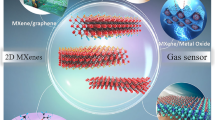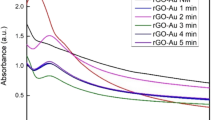Abstract
A triboelectric nanogenerator (TENG) electrode sensitive to the adsorption of water molecules has been introduced to create a self-powered humidity sensor. Graphene oxide (GO) nanosheets and graphene oxide nanoribbon (GONR) possessing oxygenated functional groups, as well as high dielectric constants, have been proposed as appropriate candidates for this purpose. GO papers have been fabricated in three forms, i.e. pure GO paper, uniform composites of GONR and GO, and double-layer structures of GONR on top of GO. Results showed that all of the prepared paper-based TENGs revealed excellent performances by maximum output voltage above 300 V. As active humidity sensors, the maximum voltage response values of 57%, 124%, and 78% were obtained for GO, GONR+GO, and GONR/GO TENGs, respectively. Besides high sensitivity and precision of all variants, GO+GONR TENG demonstrated a rapid response/recovery behavior (0.3/0.5 s). This phenomenon can be attributed to the higher oxygenated groups and defects on the edges of GONR, which leads to facilitating the bulk diffusion of water molecules. Our results open new avenues of GONR application as an additive to enhance the performance of self-powered humidity sensors, as well as conventional hygrometers.
Graphical abstract









Similar content being viewed by others
References
Wang ZL (2013) Triboelectric Nanogenerators as new energy technology for self-powered systems and as active mechanical and chemical sensors. ACS Nano 7:9533–9557. https://doi.org/10.1021/nn404614z
Wu C, Wang AC, Ding W, Guo H, Wang ZL (2019) Triboelectric nanogenerator: a foundation of the energy for the new era. Adv Energy Mater 9:1802906. https://doi.org/10.1002/aenm.201802906
Wang S, Lin L, Wang ZL (2015) Triboelectric nanogenerators as self-powered active sensors. Nano Energy 11:436–462. https://doi.org/10.1016/j.nanoen.2014.10.034
Lv C, Hu C, Luo J, Liu S, Qiao Y, Zhang Z, Song J, Shi Y, Cai J, Watanabe A (2019) Recent advances in graphene-based humidity sensors. Nanomaterials 9:422. https://doi.org/10.3390/nano9030422
Joshi N, Hayasaka T, Liu Y, Liu H, Oliveira ON Jr, Lin L (2018) A review on chemiresistive room temperature gas sensors based on metal oxide nanostructures, graphene and 2D transition metal dichalcogenides. Microchim Acta 185:213. https://doi.org/10.1007/s00604-018-2750-5
Bi H, Yin K, Xie X, et al Ultrahigh humidity sensitivity of graphene oxide. Sci Rep 7
Borini S, White R, Wei D, Astley M, Haque S, Spigone E, Harris N, Kivioja J, Ryhänen T (2013) Ultrafast graphene oxide humidity sensors. ACS Nano 7:11166–11173. https://doi.org/10.1021/nn404889b
Park EU, Choi BI, Kim JC, Woo SB, Kim YG, Choi Y, Lee SW (2018) Correlation between the sensitivity and the hysteresis of humidity sensors based on graphene oxides. Sens Actuators B Chem 258:255–262. https://doi.org/10.1016/j.snb.2017.11.104
Wan N, Wang T, Tan X, Lu S, Zhou LL, Huang JQ, Pan W, Yang YM, Shao ZY (2018) Microstructure related synergic sensoring mechanism in graphene oxide humidity sensor. J Phys Chem C 122:830–838. https://doi.org/10.1021/acs.jpcc.7b09744
Wee B-H, Khoh W-H, Sarker AK, Lee CH, Hong JD (2015) A high-performance moisture sensor based on ultralarge graphene oxide. Nanoscale 7:17805–17811. https://doi.org/10.1039/C5NR05726D
Zhu C, Tao L-Q, Wang Y, Zheng K, Yu J, L X, Chen X, Huang Y (2020) Graphene oxide humidity sensor with laser-induced graphene porous electrodes. Sens Actuators B Chem 325:128790. https://doi.org/10.1016/j.snb.2020.128790
Toda K, Furue R, Hayami S (2015) Recent progress in applications of graphene oxide for gas sensing: a review. Anal Chim Acta 878:43–53. https://doi.org/10.1016/j.aca.2015.02.002
Ejehi F, Mohammadpour R, Asadian E, Sasanpour P, Fardindoost S, Akhavan O (2020) Graphene oxide papers in nanogenerators for self-powered humidity sensing by finger tapping. Sci Rep 10:7312. https://doi.org/10.1038/s41598-020-64490-7
Li N (2017) Ultrahigh humidity sensitivity of graphene oxide combined with Ag nanoparticles RSC Adv 9
Zhang D, Tong J, Xia B, Xue Q (2014) Ultrahigh performance humidity sensor based on layer-by-layer self-assembly of graphene oxide/polyelectrolyte nanocomposite film. Sens Actuators B Chem 203:263–270. https://doi.org/10.1016/j.snb.2014.06.116
Leng X, Luo D, Xu Z, Wang F (2018) Modified graphene oxide/Nafion composite humidity sensor and its linear response to the relative humidity. Sens Actuators B Chem 257:372–381. https://doi.org/10.1016/j.snb.2017.10.174
Xu J, Gu S, Lu B (2015) Graphene and graphene oxide double decorated SnO 2 nanofibers with enhanced humidity sensing performance. RSC Adv 5:72046–72050. https://doi.org/10.1039/C5RA10571D
Zhang D, Liu J, Xia B (2016) Layer-by-layer self-assembly of zinc oxide/graphene oxide hybrid toward ultrasensitive humidity sensing. IEEE Electron Device Lett 37:916–919. https://doi.org/10.1109/LED.2016.2565728
Sun L, Haidry AA, Fatima Q, Li Z, Yao Z (2018) Improving the humidity sensing below 30% RH of TiO2 with GO modification. Mater Res Bull 99:124–131. https://doi.org/10.1016/j.materresbull.2017.11.001
Fu T, Zhu J, Zhuo M, Guan B, Li J, Xu Z, Li Q (2014) Humidity sensors based on graphene/SnO x /CF nanocomposites. J Mater Chem C 2:4861–4866. https://doi.org/10.1039/C4TC00440J
Li B, Tian Q, Su H, Wang X, Wang T, Zhang D (2019) High sensitivity portable capacitive humidity sensor based on In2O3 nanocubes-decorated GO nanosheets and its wearable application in respiration detection. Sens Actuators B Chem 299:126973. https://doi.org/10.1016/j.snb.2019.126973
Burman D, Ghosh R, Santra S, Guha PK (2016) Highly proton conducting MoS 2 /graphene oxide nanocomposite based chemoresistive humidity sensor. RSC Adv 6:57424–57433. https://doi.org/10.1039/C6RA11961A
Jha RK, Burman D, Santra S, Guha PK (2017) WS 2 /GO nanohybrids for enhanced relative humidity sensing at room temperature. IEEE Sensors J 17:7340–7347. https://doi.org/10.1109/JSEN.2017.2757243
Liu B, Sun H, Peng T, Yang J, Ren Y, Ma J, Tang G, Wang L, Huang S (2020) High selectivity humidity sensors of functionalized graphite oxide with more epoxy groups. Appl Surf Sci 503:144312. https://doi.org/10.1016/j.apsusc.2019.144312
Wang C, Zhang L, Huang H, Xi R, Jiang DP, Zhang SH, Wang LJ, Chen ZY, Pan GB (2019) A nanocomposite consisting of ZnO decorated graphene oxide nanoribbons for resistive sensing of NO2 gas at room temperature. Microchim Acta 186:554. https://doi.org/10.1007/s00604-019-3628-x
Higginbotham AL, Kosynkin DV, Sinitskii A, Sun Z, Tour JM (2010) Lower-defect graphene oxide nanoribbons from multiwalled carbon nanotubes. ACS Nano 4:2059–2069. https://doi.org/10.1021/nn100118m
Asadian E, Shahrokhian S, Zad AI, Jokar E (2014) In-situ electro-polymerization of graphene nanoribbon/polyaniline composite film: application to sensitive electrochemical detection of dobutamine. Sens Actuators B Chem 196:582–588. https://doi.org/10.1016/j.snb.2014.02.049
An Wong CH, Pumera M (2014) Highly conductive graphene nanoribbons from the reduction of graphene oxide nanoribbons with lithium aluminium hydride. J Mater Chem C 2:856–863. https://doi.org/10.1039/C3TC31688B
He B, Li M, Li M (2020) Electrochemical determination of sulfamethazine using a gold electrode modified with multi-walled carbon nanotubes, graphene oxide nanoribbons and branched aptamers. Microchim Acta 187:274. https://doi.org/10.1007/s00604-020-04244-4
Faniyi IO, Fasakin O, Olofinjana B, Adekunle AS, Oluwasusi TV, Eleruja MA, Ajayi EOB (2019) The comparative analyses of reduced graphene oxide (RGO) prepared via green, mild and chemical approaches. SN Appl Sci 1:1181. https://doi.org/10.1007/s42452-019-1188-7
Wang X, Hu Y, Min J, Li S, Deng X, Yuan S, Zuo X (2018) Adsorption characteristics of phenolic compounds on graphene oxide and reduced graphene oxide: a batch experiment combined theory calculation. Appl Sci 8:1950. https://doi.org/10.3390/app8101950
Loryuenyong V, Totepvimarn K, Eimburanapravat P, Boonchompoo W, Buasri A (2013) Preparation and characterization of reduced graphene oxide sheets via water-based exfoliation and reduction methods. Adv Mater Sci Eng 2013:1–5. https://doi.org/10.1155/2013/923403
Luceño-Sánchez JA, Maties G, Gonzalez-Arellano C, Díez-Pascual AM (2018) Synthesis and characterization of graphene oxide derivatives via functionalization reaction with hexamethylene diisocyanate. Proceedings 3:8. https://doi.org/10.3390/IOCN_2018-1-05485
Niu S, Wang S, Lin L, Liu Y, Zhou YS, Hu Y, Wang ZL (2013) Theoretical study of contact-mode triboelectric nanogenerators as an effective power source. Energy Environ Sci 6:3576. https://doi.org/10.1039/c3ee42571a
Lian B, De Luca S, You Y et al (2018) Extraordinary water adsorption characteristics of graphene oxide. Chem Sci 9:5106–5111. https://doi.org/10.1039/C8SC00545A
Liu R, Gong T, Zhang K, Lee C (2017) Graphene oxide papers with high water adsorption capacity for air dehumidification. Sci Rep 7:9761. https://doi.org/10.1038/s41598-017-09777-y
Yao Y, Chen X, Zhu J, et al (2012) The effect of ambient humidity on the electrical properties of graphene oxide films 7
Thommes M, Kaneko K, Neimark AV, Olivier JP, Rodriguez-Reinoso F, Rouquerol J, Sing KSW (2015) Physisorption of gases, with special reference to the evaluation of surface area and pore size distribution (IUPAC technical report). Pure Appl Chem 87:1051–1069. https://doi.org/10.1515/pac-2014-1117
Shen J, Li Z, Yu J, Ding B (2017) Humidity-resisting triboelectric nanogenerator for high performance biomechanical energy harvesting. Nano Energy 40:282–288. https://doi.org/10.1016/j.nanoen.2017.08.035
Baxter LK (1997) Capacitive sensors: design and applications, 1. Print. IEEE press, New York, NY
Feng X, Chen W, Yan L (2015) Free-standing dried foam films of graphene oxide for humidity sensing. Sens Actuators B Chem 215:316–322. https://doi.org/10.1016/j.snb.2015.03.068
An J, Le T-SD, Huang Y et al (2017) All-graphene-based highly flexible noncontact electronic skin. ACS Appl Mater Interfaces 9:44593–44601. https://doi.org/10.1021/acsami.7b13701
Huang Y, Cheng H, Shi G, Qu L (2017) Highly efficient moisture-triggered nanogenerator based on graphene quantum dots. ACS Appl Mater Interfaces 9:38170–38175. https://doi.org/10.1021/acsami.7b12542
Su Y, Xie G, Wang S, Tai H, Zhang Q, du H, Zhang H, du X, Jiang Y (2017) Novel high-performance self-powered humidity detection enabled by triboelectric effect. Sens Actuators B Chem 251:144–152. https://doi.org/10.1016/j.snb.2017.04.039
Acknowledgments
We gratefully acknowledge financial support from the Iran National Science Foundation (INSF, Num: 98005876) and the Office of Research Affairs of Sharif University of Technology (QA971617).
Author information
Authors and Affiliations
Corresponding authors
Ethics declarations
Conflict of interest
The authors declare that they have no competing of interests.
Additional information
Publisher’s note
Springer Nature remains neutral with regard to jurisdictional claims in published maps and institutional affiliations.
Supplementary Information
ESM 1
(DOCX 330 kb)
Rights and permissions
About this article
Cite this article
Ejehi, F., Mohammadpour, R., Asadian, E. et al. Enhancement of self-powered humidity sensing of graphene oxide–based triboelectric nanogenerators by addition of graphene oxide nanoribbons. Microchim Acta 188, 251 (2021). https://doi.org/10.1007/s00604-021-04921-y
Received:
Accepted:
Published:
DOI: https://doi.org/10.1007/s00604-021-04921-y




